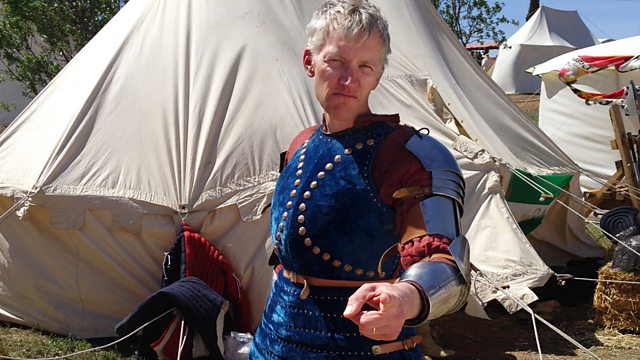Jazz in the Trenches, Woad, Notting Hill Carnival
Tom Holland and guests consider jazz in the trenches, woad and the women behind the Notting Hill Carnival.
Tom Holland is joined by Dr Lucy Robinson from the University of Sussex to consider jazz in the trenches, woad and the women behind the Notting Hill Carnival.
Helen Castor meets Dr Michael Hammond, Associate Professor at the University of Southampton, to hear about Blues in the Trenches. Dr Hammond argues that 'the blues' as a musical tradition was brought to the trenches of the Great War by African-American soldiers from all parts of the US and they shared different performance styles and traditions - creating cross-pollinations that foreshadow the country blues recordings of the 1920s and 30s by Charley Patton, Furry Lewis, Bukka White, Geechie Wiley, Ma Rainey, Elvey Thomas, Blind Willie Johnson and notable others.
Closer to home, on the banks of the River Thames, Iszi Lawrence traces the origins of today's craze for tattoos and body art back to the Celts, when she learns to make woad.
On the eve of the Notting Hill Carnival, comic Ava Vidal nominates the activist, feminist, socialist and founder of the Carnival Claudia Jones for the Making History plinth.
Producer: Nick Patrick
A Pier production for 大象传媒 Radio 4.
Last on
More information
Tom Holland and guests discuss the stories that are Making History.
Today, Tom is joined by the historian of alternative spiritualities, gender and sexuality Dr Lucy Robinson of the University of Sussex.听 and from the School of History, Classics and Archaeology at the University of Newcastle, the historian of Modern America Dr Bruce Baker.
听
WW1 and the Blues
The history of the music of the First World War most usually looks at the songs of the concert party, music hall or military. However, new research is showing that the Western Front, or at least the supply lines to it, were hugely important in the development of a type of music that came to dominate popular culture throughout the twentieth century: the blues.
As Helen Castor discovered when she met with Dr Mike Hammond from the University of Southampton, the American army was segregated when the USA entered the First World War in 1917. Most black troops worked in construction or supply and were based away from the front lines. However, their posting to France allowed them to mix with other African-Americans, something which was incredibly difficult back at home because of the racist Jim Crow laws. The cultural impact was huge: Black Americans from different communities sharing their ideas, experiences and music. Blues, already becoming commercially popular in the USA, was given a further boost.
Dr Mike Hammond听
Jim Crow Museum at Ferris State University
American Involvement in World War 1
Africana Age at New York Public Library
听
Claudia Jones
Each week we ask a writer, performer or historian to nominate someone who has been passed over by history despite being influential during their lifetime. This week comic Ava Vidal argues the case for the civil rights campaigner and community activist who helped start the Notting Hill Carnival, Claudia Jones.
听
100 Great Black Britons听
20th Century London听
Institute of Race Relations
Ava Vidal
听
Woad
We tend to think that our Celtic ancestors (in particular the Picts) used woad as a natural ingredient for body art of some kind.. Julius Caesar is most likely to be the source of this historical rumour in his autobiographical The Gallic War - heavily supported by the public school song from the 1920鈥檚: The National Anthem of the Ancient Britons (set to the tune Men of Harlech). Truth be told, we know very little about woad鈥檚 uses until the late medieval period when evidence for its use as a textile dye surfaces.. The likelihood is that this very old plant was used in textile production for centuries and those using it would be stained blue. This might have led to people using it for body art but all the archaeological evidence shows that copper and not woad is present in ancient tattooing.
To understand how dyes are produced from woad and whether it could be used to create body art, Making History鈥檚 Iszi Lawrence went to meet the experimental archaeologist Romilly Swann who works for an educational organisation called Earth Trust at her house by the River Thames near Reading.
Earth Trust听
University of Reading Department of Archaeology
Woad in Britain
听
Tattoos
Tom Holland and Lucy Robinson venture on to the streets of Brighton to a tattoo studio called Into You to meet the natural, non-electric body artist Adam Sage. They discuss why tattooing has become more acceptable and how historians can interrogate body art as a resource.
Bella Volen听
大象传媒 Culture
Daily Mail听
Making History is produced by Nick Patrick and is a Pier Production for 大象传媒 Radio 4
听
Broadcasts
- Tue 23 Aug 2016 15:00大象传媒 Radio 4
- Mon 24 Sep 2018 23:30大象传媒 Radio 4
Podcast
-
![]()
Making History
Popular history series where the past connects with the present.


